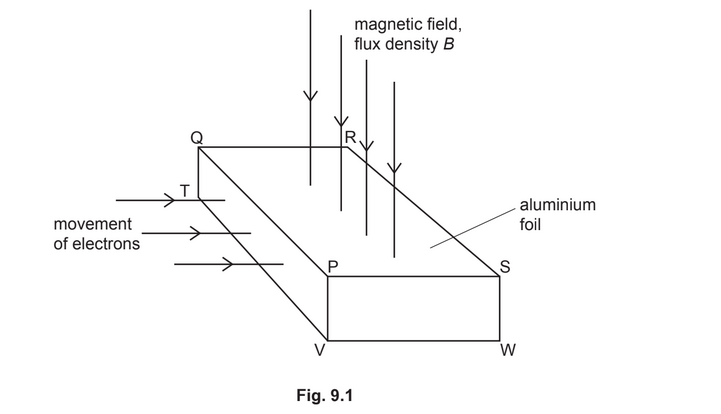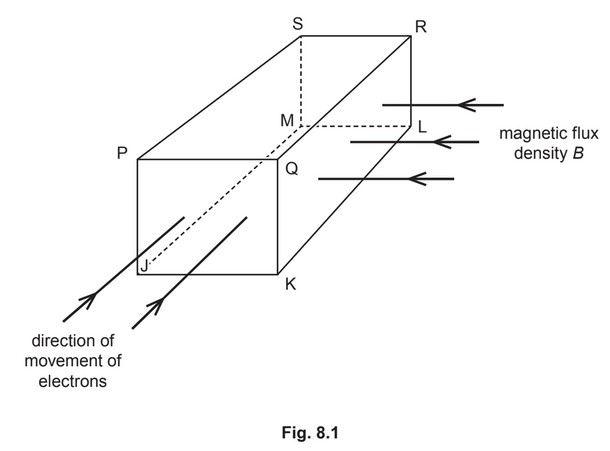Question
(a) State what is meant by a magnetic field.
…………………………………………………………………………………………………………………………………
…………………………………………………………………………………………………………………………………
…………………………………………………………………………………………………………………………… [2]
(b) A rectangular piece of aluminium foil is situated in a uniform magnetic field of flux density B, as shown in Fig. 9.1.
The magnetic field is normal to the face PQRS of the foil. Electrons, each of charge −q, enter the foil at right angles to the face PQTV.
(i) On Fig. 9.1, shade the face of the foil on which electrons initially accumulate. [1]
(ii) Explain why electrons do not continuously accumulate on the face you have shaded.
………………………………………………………………………………………………………………………….
………………………………………………………………………………………………………………………….
………………………………………………………………………………………………………………………….
……………………………………………………………………………………………………………………. [3]
(c) The Hall voltage \(V_H\) developed across the foil in (b) is given by the expression
\(V_H =\frac{ BI}{ ntq}\)
where I is the current in the foil.
(i) State the meaning of the quantity n.
………………………………………………………………………………………………………………………….
……………………………………………………………………………………………………………………. [1]
(ii) Using the letters on Fig. 9.1, identify the distance t.
……………………………………………………………………………………………………………………. [1]
(d) Suggest why, in practice, Hall probes are usually made using a semiconductor material rather than a metal.
…………………………………………………………………………………………………………………………………
…………………………………………………………………………………………………………………………… [1]
[Total: 9]
Answer/Explanation
Ans:
(a) region where there is a force exerted on a current-carrying conductor
or
a moving charge
or
a magnetic material/magnetic pole
(b)(i) face PSWV shaded
(b)(ii) accumulating electrons cause an electric field (between the faces)
force due to electric field opposes force due to magnetic field
accumulation stops when magnetic force equals electric force
(c)(i) number density of charge carriers
(c)(ii) PV or QT or SW
Question
A slice of a conducting material has its face QRLK normal to a uniform magnetic field of flux
density B, as illustrated in Fig. 8.1.
Electrons enter the slice travelling perpendicular to face PQKJ.
(a) For the free electrons moving in the slice:
(i) state the direction of the force on an electron due to movement of the electron in the magnetic field
(ii) identify the faces, using the letters on Fig. 8.1, between which a potential difference is developed.
face …………………………… and face ……………………………
(b) Explain why the potential difference in (a)(ii) reaches a maximum value.
(c) The number of free electrons per unit volume in the slice of material is \(1.3 × 10^{29}m^{–3}\).
The thickness PQ of the slice is 0.10mm.
The magnetic flux density B is \(4.6 × 10^{–3}\)T.
Calculate the potential difference across the slice for a current of \(6.3 × 10^{–4}\)A.
potential difference = ……………………………………………… V
(d) The slice in (c) is a metal.
By reference to your answer in (c), suggest why Hall probes are usually made using
semiconductors rather than metals.
Answer/Explanation
Answer:
(a) (i) downwards
(ii) PQRS and JKLM
(b) (as charge separates) an electric field is created (between opposite faces)
(maximum value is reached when) electric force (on electron) is equal and opposite to magnetic force (on electron)
(c) \(V_H = B I / ntq \)
= \((4.6 × 10^{–3} × 6.3 × 10^{–4}) / (1.3 × 10^{29} × 0.10 × 10^{–3} × 1.60 × 10^{–19})\)
\(= 1.4 \times 10^{-12} V\)
(d) semiconductors have a (much) smaller value for n
